Employee Relations and HRM Practices
VerifiedAdded on 2020/01/07
|14
|4903
|471
Literature Review
AI Summary
This assignment delves into the crucial relationship between Human Resource Management (HRM) practices and employee relations. It examines how various HRM approaches, such as talent acquisition, performance management, and training & development, influence factors like employee satisfaction, motivation, conflict resolution, negotiation skills, and overall engagement. The document analyzes relevant literature and case studies to highlight the best practices for fostering positive employee relations through effective HRM strategies.
Contribute Materials
Your contribution can guide someone’s learning journey. Share your
documents today.
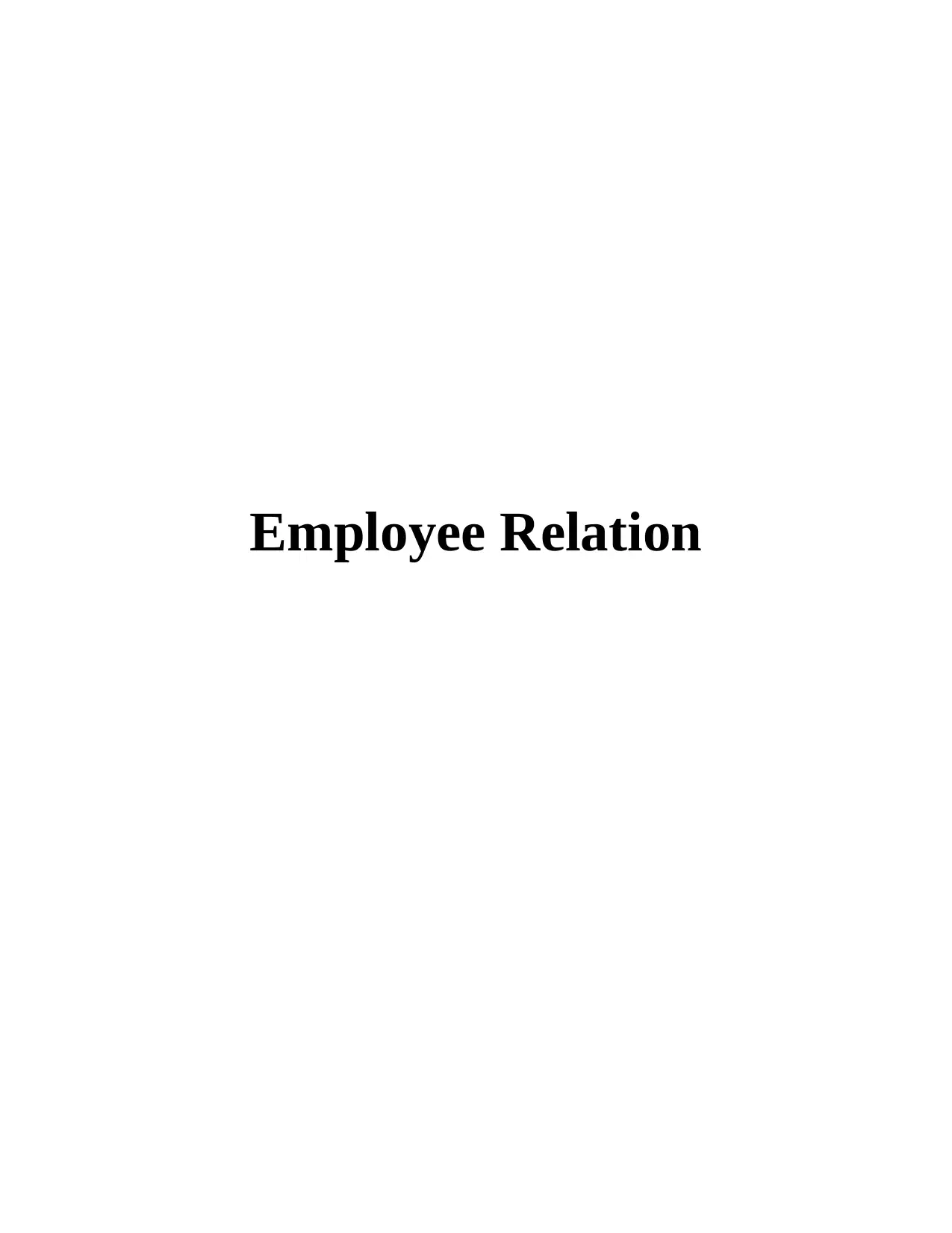
Employee Relation
Secure Best Marks with AI Grader
Need help grading? Try our AI Grader for instant feedback on your assignments.
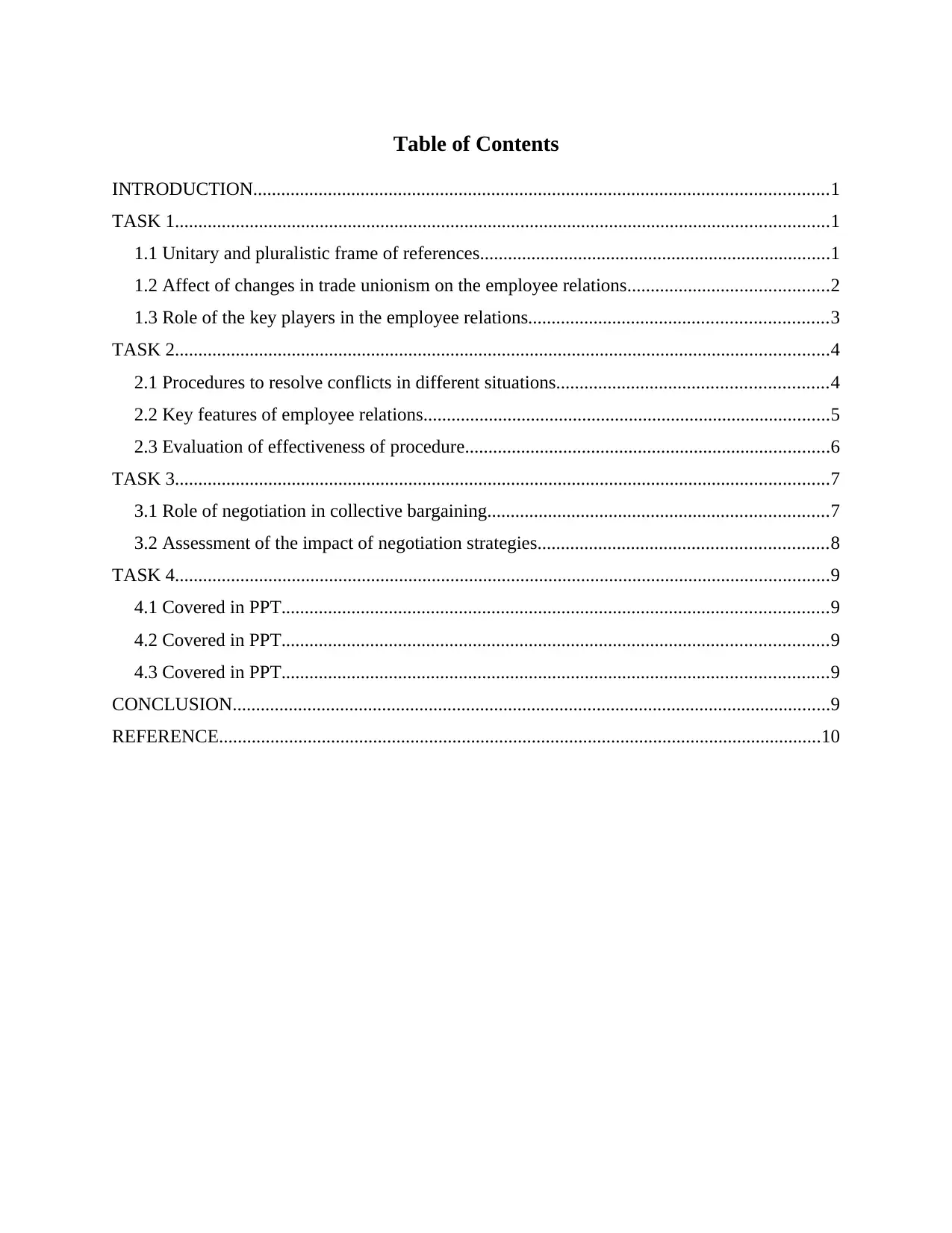
Table of Contents
INTRODUCTION...........................................................................................................................1
TASK 1............................................................................................................................................1
1.1 Unitary and pluralistic frame of references...........................................................................1
1.2 Affect of changes in trade unionism on the employee relations...........................................2
1.3 Role of the key players in the employee relations................................................................3
TASK 2............................................................................................................................................4
2.1 Procedures to resolve conflicts in different situations..........................................................4
2.2 Key features of employee relations.......................................................................................5
2.3 Evaluation of effectiveness of procedure..............................................................................6
TASK 3............................................................................................................................................7
3.1 Role of negotiation in collective bargaining.........................................................................7
3.2 Assessment of the impact of negotiation strategies..............................................................8
TASK 4............................................................................................................................................9
4.1 Covered in PPT.....................................................................................................................9
4.2 Covered in PPT.....................................................................................................................9
4.3 Covered in PPT.....................................................................................................................9
CONCLUSION................................................................................................................................9
REFERENCE.................................................................................................................................10
INTRODUCTION...........................................................................................................................1
TASK 1............................................................................................................................................1
1.1 Unitary and pluralistic frame of references...........................................................................1
1.2 Affect of changes in trade unionism on the employee relations...........................................2
1.3 Role of the key players in the employee relations................................................................3
TASK 2............................................................................................................................................4
2.1 Procedures to resolve conflicts in different situations..........................................................4
2.2 Key features of employee relations.......................................................................................5
2.3 Evaluation of effectiveness of procedure..............................................................................6
TASK 3............................................................................................................................................7
3.1 Role of negotiation in collective bargaining.........................................................................7
3.2 Assessment of the impact of negotiation strategies..............................................................8
TASK 4............................................................................................................................................9
4.1 Covered in PPT.....................................................................................................................9
4.2 Covered in PPT.....................................................................................................................9
4.3 Covered in PPT.....................................................................................................................9
CONCLUSION................................................................................................................................9
REFERENCE.................................................................................................................................10

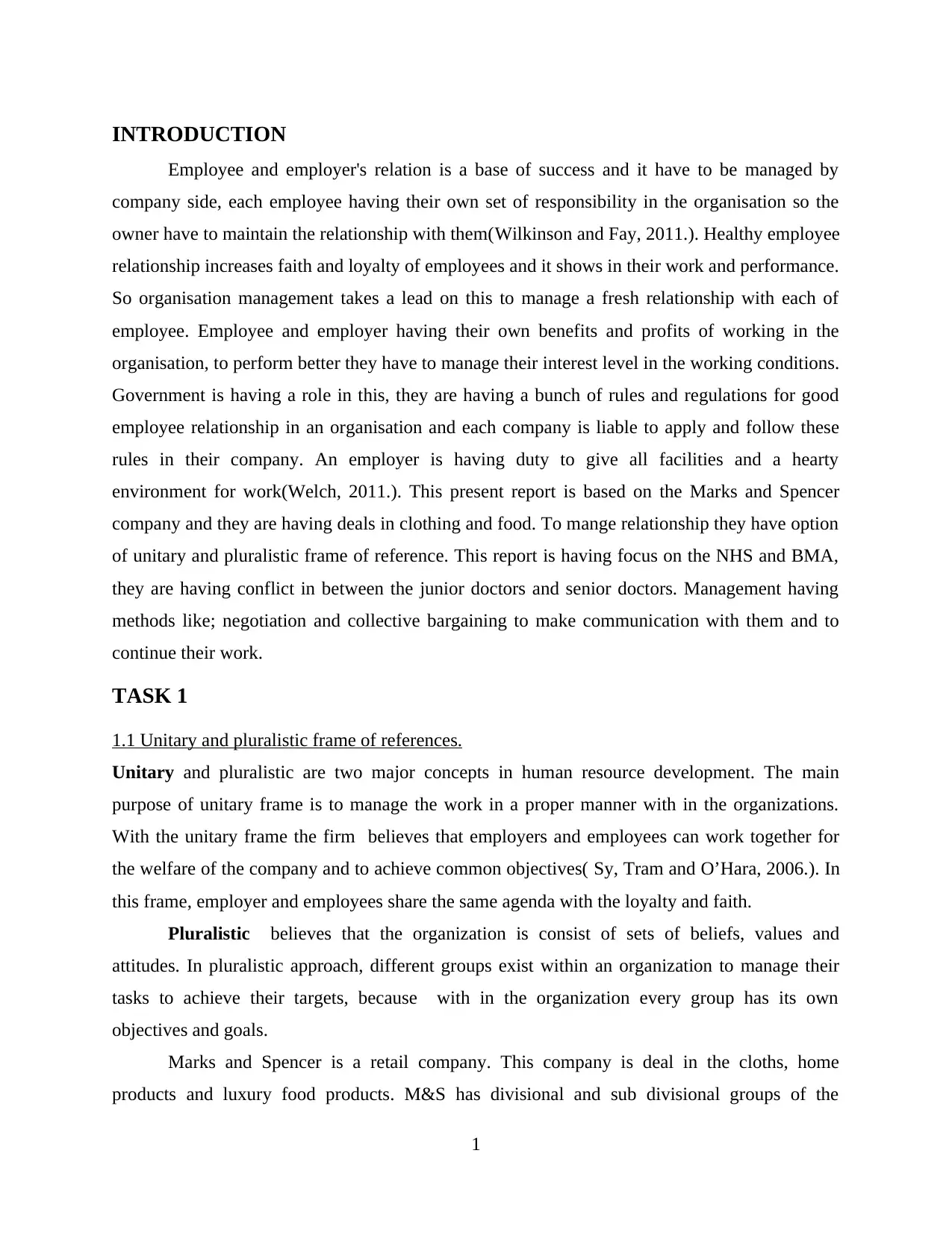
INTRODUCTION
Employee and employer's relation is a base of success and it have to be managed by
company side, each employee having their own set of responsibility in the organisation so the
owner have to maintain the relationship with them(Wilkinson and Fay, 2011.). Healthy employee
relationship increases faith and loyalty of employees and it shows in their work and performance.
So organisation management takes a lead on this to manage a fresh relationship with each of
employee. Employee and employer having their own benefits and profits of working in the
organisation, to perform better they have to manage their interest level in the working conditions.
Government is having a role in this, they are having a bunch of rules and regulations for good
employee relationship in an organisation and each company is liable to apply and follow these
rules in their company. An employer is having duty to give all facilities and a hearty
environment for work(Welch, 2011.). This present report is based on the Marks and Spencer
company and they are having deals in clothing and food. To mange relationship they have option
of unitary and pluralistic frame of reference. This report is having focus on the NHS and BMA,
they are having conflict in between the junior doctors and senior doctors. Management having
methods like; negotiation and collective bargaining to make communication with them and to
continue their work.
TASK 1
1.1 Unitary and pluralistic frame of references.
Unitary and pluralistic are two major concepts in human resource development. The main
purpose of unitary frame is to manage the work in a proper manner with in the organizations.
With the unitary frame the firm believes that employers and employees can work together for
the welfare of the company and to achieve common objectives( Sy, Tram and O’Hara, 2006.). In
this frame, employer and employees share the same agenda with the loyalty and faith.
Pluralistic believes that the organization is consist of sets of beliefs, values and
attitudes. In pluralistic approach, different groups exist within an organization to manage their
tasks to achieve their targets, because with in the organization every group has its own
objectives and goals.
Marks and Spencer is a retail company. This company is deal in the cloths, home
products and luxury food products. M&S has divisional and sub divisional groups of the
1
Employee and employer's relation is a base of success and it have to be managed by
company side, each employee having their own set of responsibility in the organisation so the
owner have to maintain the relationship with them(Wilkinson and Fay, 2011.). Healthy employee
relationship increases faith and loyalty of employees and it shows in their work and performance.
So organisation management takes a lead on this to manage a fresh relationship with each of
employee. Employee and employer having their own benefits and profits of working in the
organisation, to perform better they have to manage their interest level in the working conditions.
Government is having a role in this, they are having a bunch of rules and regulations for good
employee relationship in an organisation and each company is liable to apply and follow these
rules in their company. An employer is having duty to give all facilities and a hearty
environment for work(Welch, 2011.). This present report is based on the Marks and Spencer
company and they are having deals in clothing and food. To mange relationship they have option
of unitary and pluralistic frame of reference. This report is having focus on the NHS and BMA,
they are having conflict in between the junior doctors and senior doctors. Management having
methods like; negotiation and collective bargaining to make communication with them and to
continue their work.
TASK 1
1.1 Unitary and pluralistic frame of references.
Unitary and pluralistic are two major concepts in human resource development. The main
purpose of unitary frame is to manage the work in a proper manner with in the organizations.
With the unitary frame the firm believes that employers and employees can work together for
the welfare of the company and to achieve common objectives( Sy, Tram and O’Hara, 2006.). In
this frame, employer and employees share the same agenda with the loyalty and faith.
Pluralistic believes that the organization is consist of sets of beliefs, values and
attitudes. In pluralistic approach, different groups exist within an organization to manage their
tasks to achieve their targets, because with in the organization every group has its own
objectives and goals.
Marks and Spencer is a retail company. This company is deal in the cloths, home
products and luxury food products. M&S has divisional and sub divisional groups of the
1
Secure Best Marks with AI Grader
Need help grading? Try our AI Grader for instant feedback on your assignments.
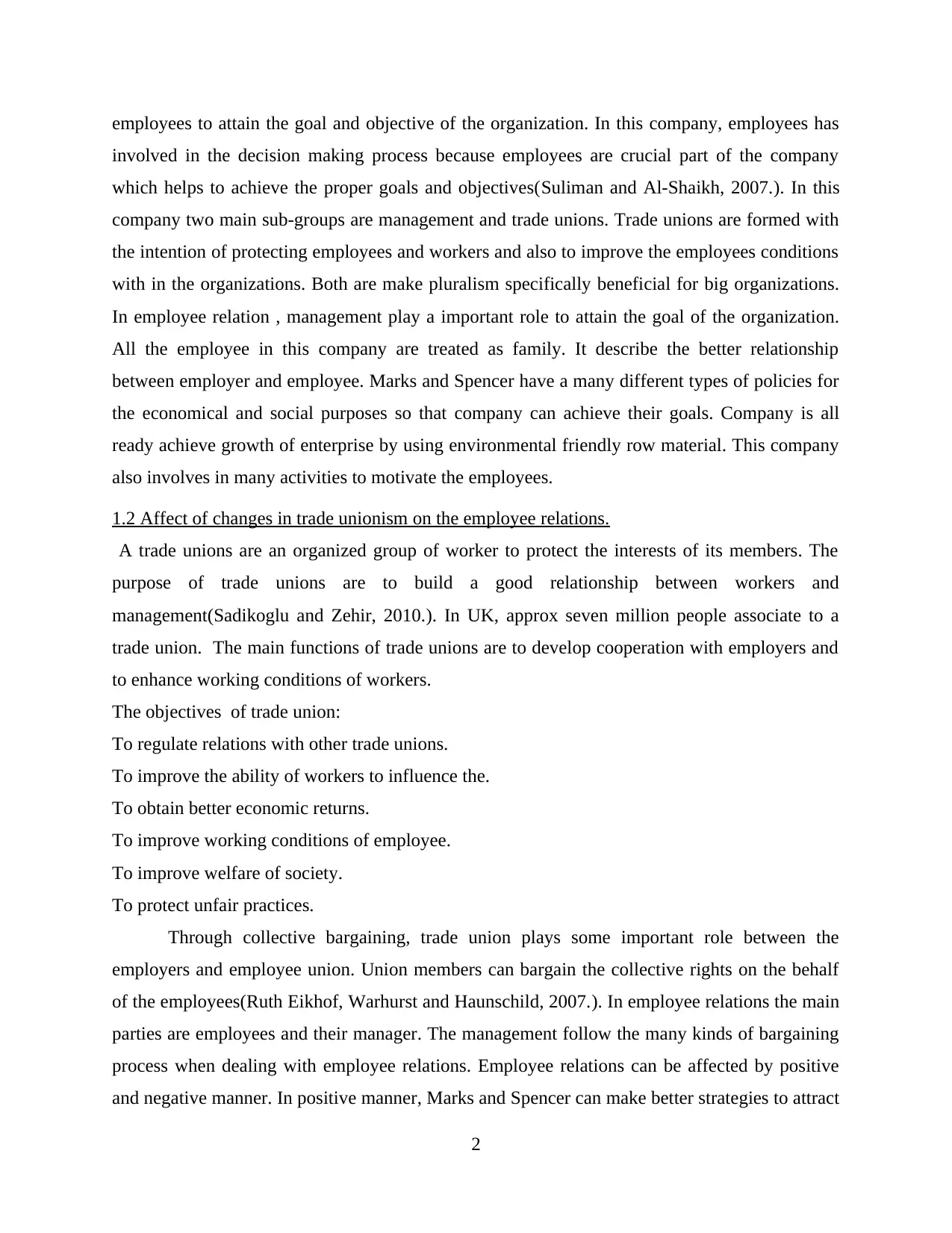
employees to attain the goal and objective of the organization. In this company, employees has
involved in the decision making process because employees are crucial part of the company
which helps to achieve the proper goals and objectives(Suliman and Al-Shaikh, 2007.). In this
company two main sub-groups are management and trade unions. Trade unions are formed with
the intention of protecting employees and workers and also to improve the employees conditions
with in the organizations. Both are make pluralism specifically beneficial for big organizations.
In employee relation , management play a important role to attain the goal of the organization.
All the employee in this company are treated as family. It describe the better relationship
between employer and employee. Marks and Spencer have a many different types of policies for
the economical and social purposes so that company can achieve their goals. Company is all
ready achieve growth of enterprise by using environmental friendly row material. This company
also involves in many activities to motivate the employees.
1.2 Affect of changes in trade unionism on the employee relations.
A trade unions are an organized group of worker to protect the interests of its members. The
purpose of trade unions are to build a good relationship between workers and
management(Sadikoglu and Zehir, 2010.). In UK, approx seven million people associate to a
trade union. The main functions of trade unions are to develop cooperation with employers and
to enhance working conditions of workers.
The objectives of trade union:
To regulate relations with other trade unions.
To improve the ability of workers to influence the.
To obtain better economic returns.
To improve working conditions of employee.
To improve welfare of society.
To protect unfair practices.
Through collective bargaining, trade union plays some important role between the
employers and employee union. Union members can bargain the collective rights on the behalf
of the employees(Ruth Eikhof, Warhurst and Haunschild, 2007.). In employee relations the main
parties are employees and their manager. The management follow the many kinds of bargaining
process when dealing with employee relations. Employee relations can be affected by positive
and negative manner. In positive manner, Marks and Spencer can make better strategies to attract
2
involved in the decision making process because employees are crucial part of the company
which helps to achieve the proper goals and objectives(Suliman and Al-Shaikh, 2007.). In this
company two main sub-groups are management and trade unions. Trade unions are formed with
the intention of protecting employees and workers and also to improve the employees conditions
with in the organizations. Both are make pluralism specifically beneficial for big organizations.
In employee relation , management play a important role to attain the goal of the organization.
All the employee in this company are treated as family. It describe the better relationship
between employer and employee. Marks and Spencer have a many different types of policies for
the economical and social purposes so that company can achieve their goals. Company is all
ready achieve growth of enterprise by using environmental friendly row material. This company
also involves in many activities to motivate the employees.
1.2 Affect of changes in trade unionism on the employee relations.
A trade unions are an organized group of worker to protect the interests of its members. The
purpose of trade unions are to build a good relationship between workers and
management(Sadikoglu and Zehir, 2010.). In UK, approx seven million people associate to a
trade union. The main functions of trade unions are to develop cooperation with employers and
to enhance working conditions of workers.
The objectives of trade union:
To regulate relations with other trade unions.
To improve the ability of workers to influence the.
To obtain better economic returns.
To improve working conditions of employee.
To improve welfare of society.
To protect unfair practices.
Through collective bargaining, trade union plays some important role between the
employers and employee union. Union members can bargain the collective rights on the behalf
of the employees(Ruth Eikhof, Warhurst and Haunschild, 2007.). In employee relations the main
parties are employees and their manager. The management follow the many kinds of bargaining
process when dealing with employee relations. Employee relations can be affected by positive
and negative manner. In positive manner, Marks and Spencer can make better strategies to attract
2
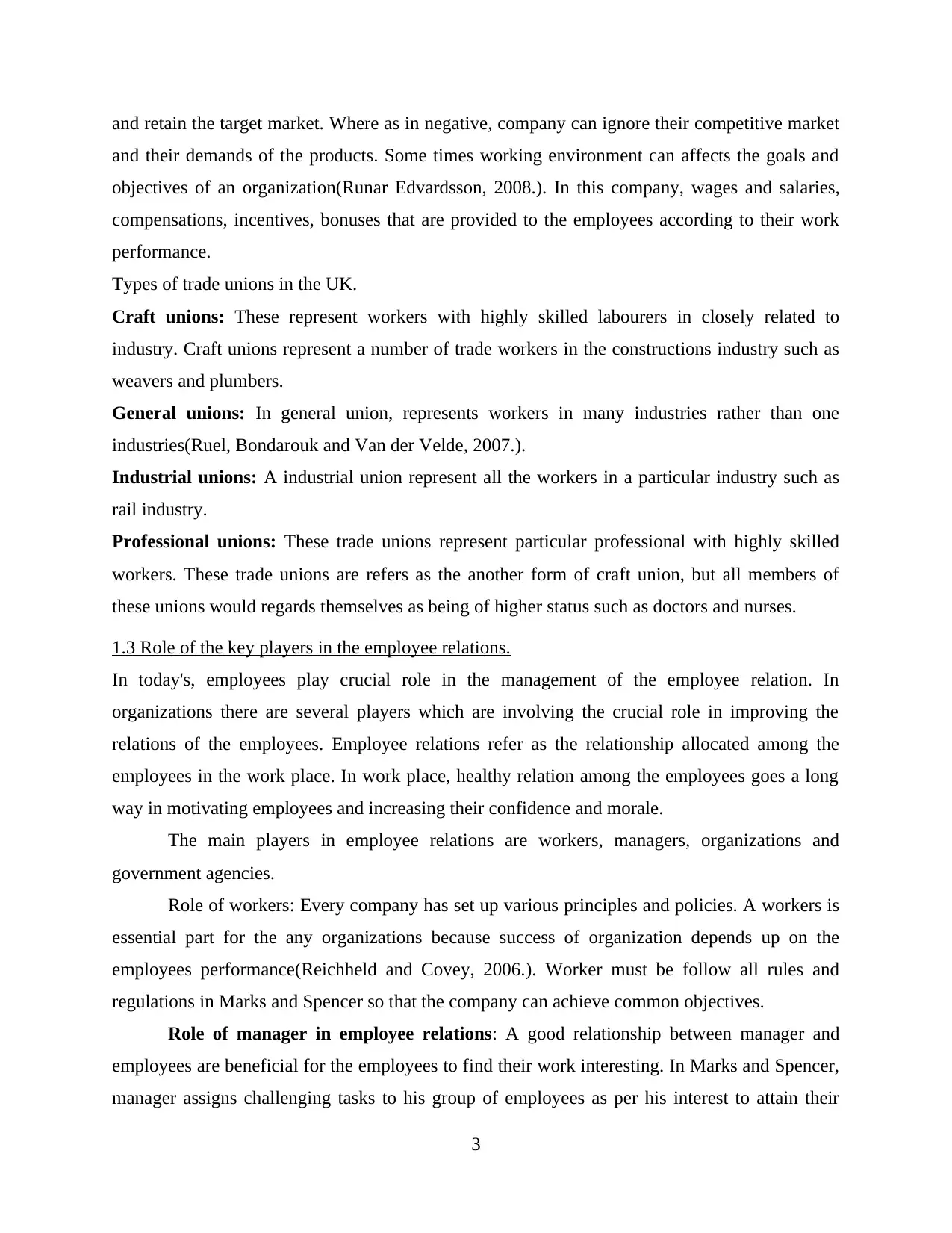
and retain the target market. Where as in negative, company can ignore their competitive market
and their demands of the products. Some times working environment can affects the goals and
objectives of an organization(Runar Edvardsson, 2008.). In this company, wages and salaries,
compensations, incentives, bonuses that are provided to the employees according to their work
performance.
Types of trade unions in the UK.
Craft unions: These represent workers with highly skilled labourers in closely related to
industry. Craft unions represent a number of trade workers in the constructions industry such as
weavers and plumbers.
General unions: In general union, represents workers in many industries rather than one
industries(Ruel, Bondarouk and Van der Velde, 2007.).
Industrial unions: A industrial union represent all the workers in a particular industry such as
rail industry.
Professional unions: These trade unions represent particular professional with highly skilled
workers. These trade unions are refers as the another form of craft union, but all members of
these unions would regards themselves as being of higher status such as doctors and nurses.
1.3 Role of the key players in the employee relations.
In today's, employees play crucial role in the management of the employee relation. In
organizations there are several players which are involving the crucial role in improving the
relations of the employees. Employee relations refer as the relationship allocated among the
employees in the work place. In work place, healthy relation among the employees goes a long
way in motivating employees and increasing their confidence and morale.
The main players in employee relations are workers, managers, organizations and
government agencies.
Role of workers: Every company has set up various principles and policies. A workers is
essential part for the any organizations because success of organization depends up on the
employees performance(Reichheld and Covey, 2006.). Worker must be follow all rules and
regulations in Marks and Spencer so that the company can achieve common objectives.
Role of manager in employee relations: A good relationship between manager and
employees are beneficial for the employees to find their work interesting. In Marks and Spencer,
manager assigns challenging tasks to his group of employees as per his interest to attain their
3
and their demands of the products. Some times working environment can affects the goals and
objectives of an organization(Runar Edvardsson, 2008.). In this company, wages and salaries,
compensations, incentives, bonuses that are provided to the employees according to their work
performance.
Types of trade unions in the UK.
Craft unions: These represent workers with highly skilled labourers in closely related to
industry. Craft unions represent a number of trade workers in the constructions industry such as
weavers and plumbers.
General unions: In general union, represents workers in many industries rather than one
industries(Ruel, Bondarouk and Van der Velde, 2007.).
Industrial unions: A industrial union represent all the workers in a particular industry such as
rail industry.
Professional unions: These trade unions represent particular professional with highly skilled
workers. These trade unions are refers as the another form of craft union, but all members of
these unions would regards themselves as being of higher status such as doctors and nurses.
1.3 Role of the key players in the employee relations.
In today's, employees play crucial role in the management of the employee relation. In
organizations there are several players which are involving the crucial role in improving the
relations of the employees. Employee relations refer as the relationship allocated among the
employees in the work place. In work place, healthy relation among the employees goes a long
way in motivating employees and increasing their confidence and morale.
The main players in employee relations are workers, managers, organizations and
government agencies.
Role of workers: Every company has set up various principles and policies. A workers is
essential part for the any organizations because success of organization depends up on the
employees performance(Reichheld and Covey, 2006.). Worker must be follow all rules and
regulations in Marks and Spencer so that the company can achieve common objectives.
Role of manager in employee relations: A good relationship between manager and
employees are beneficial for the employees to find their work interesting. In Marks and Spencer,
manager assigns challenging tasks to his group of employees as per his interest to attain their
3
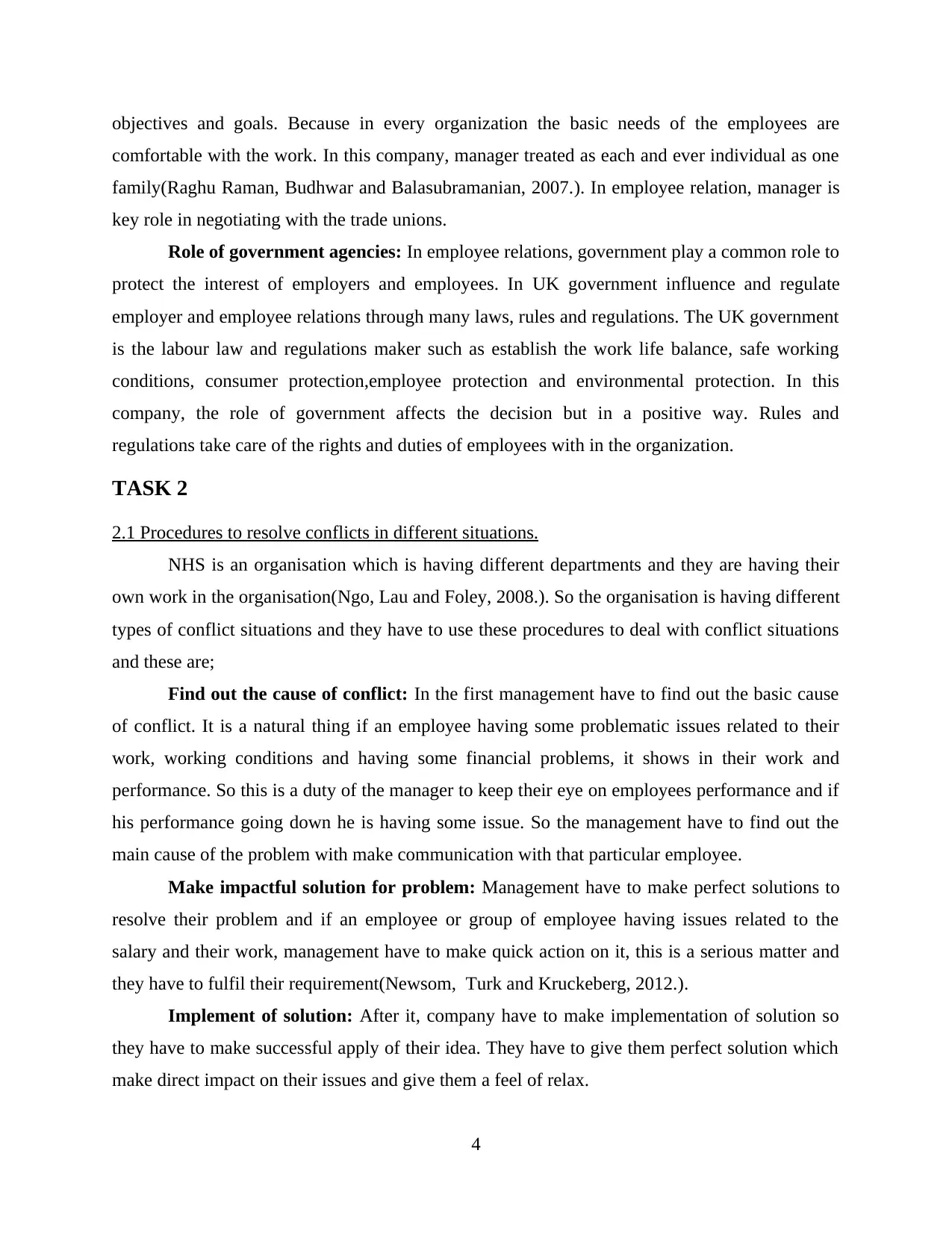
objectives and goals. Because in every organization the basic needs of the employees are
comfortable with the work. In this company, manager treated as each and ever individual as one
family(Raghu Raman, Budhwar and Balasubramanian, 2007.). In employee relation, manager is
key role in negotiating with the trade unions.
Role of government agencies: In employee relations, government play a common role to
protect the interest of employers and employees. In UK government influence and regulate
employer and employee relations through many laws, rules and regulations. The UK government
is the labour law and regulations maker such as establish the work life balance, safe working
conditions, consumer protection,employee protection and environmental protection. In this
company, the role of government affects the decision but in a positive way. Rules and
regulations take care of the rights and duties of employees with in the organization.
TASK 2
2.1 Procedures to resolve conflicts in different situations.
NHS is an organisation which is having different departments and they are having their
own work in the organisation(Ngo, Lau and Foley, 2008.). So the organisation is having different
types of conflict situations and they have to use these procedures to deal with conflict situations
and these are;
Find out the cause of conflict: In the first management have to find out the basic cause
of conflict. It is a natural thing if an employee having some problematic issues related to their
work, working conditions and having some financial problems, it shows in their work and
performance. So this is a duty of the manager to keep their eye on employees performance and if
his performance going down he is having some issue. So the management have to find out the
main cause of the problem with make communication with that particular employee.
Make impactful solution for problem: Management have to make perfect solutions to
resolve their problem and if an employee or group of employee having issues related to the
salary and their work, management have to make quick action on it, this is a serious matter and
they have to fulfil their requirement(Newsom, Turk and Kruckeberg, 2012.).
Implement of solution: After it, company have to make implementation of solution so
they have to make successful apply of their idea. They have to give them perfect solution which
make direct impact on their issues and give them a feel of relax.
4
comfortable with the work. In this company, manager treated as each and ever individual as one
family(Raghu Raman, Budhwar and Balasubramanian, 2007.). In employee relation, manager is
key role in negotiating with the trade unions.
Role of government agencies: In employee relations, government play a common role to
protect the interest of employers and employees. In UK government influence and regulate
employer and employee relations through many laws, rules and regulations. The UK government
is the labour law and regulations maker such as establish the work life balance, safe working
conditions, consumer protection,employee protection and environmental protection. In this
company, the role of government affects the decision but in a positive way. Rules and
regulations take care of the rights and duties of employees with in the organization.
TASK 2
2.1 Procedures to resolve conflicts in different situations.
NHS is an organisation which is having different departments and they are having their
own work in the organisation(Ngo, Lau and Foley, 2008.). So the organisation is having different
types of conflict situations and they have to use these procedures to deal with conflict situations
and these are;
Find out the cause of conflict: In the first management have to find out the basic cause
of conflict. It is a natural thing if an employee having some problematic issues related to their
work, working conditions and having some financial problems, it shows in their work and
performance. So this is a duty of the manager to keep their eye on employees performance and if
his performance going down he is having some issue. So the management have to find out the
main cause of the problem with make communication with that particular employee.
Make impactful solution for problem: Management have to make perfect solutions to
resolve their problem and if an employee or group of employee having issues related to the
salary and their work, management have to make quick action on it, this is a serious matter and
they have to fulfil their requirement(Newsom, Turk and Kruckeberg, 2012.).
Implement of solution: After it, company have to make implementation of solution so
they have to make successful apply of their idea. They have to give them perfect solution which
make direct impact on their issues and give them a feel of relax.
4
Paraphrase This Document
Need a fresh take? Get an instant paraphrase of this document with our AI Paraphraser
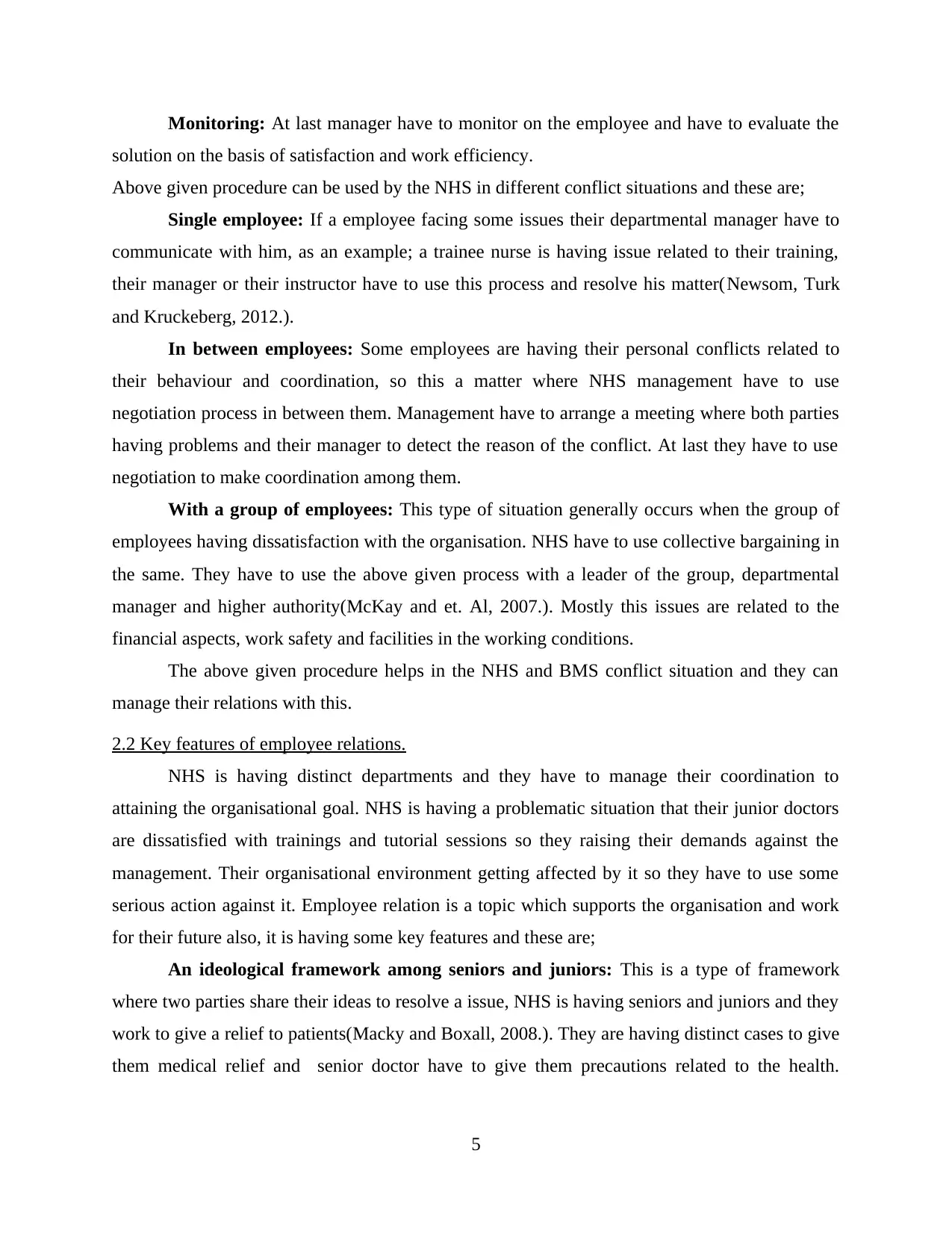
Monitoring: At last manager have to monitor on the employee and have to evaluate the
solution on the basis of satisfaction and work efficiency.
Above given procedure can be used by the NHS in different conflict situations and these are;
Single employee: If a employee facing some issues their departmental manager have to
communicate with him, as an example; a trainee nurse is having issue related to their training,
their manager or their instructor have to use this process and resolve his matter(Newsom, Turk
and Kruckeberg, 2012.).
In between employees: Some employees are having their personal conflicts related to
their behaviour and coordination, so this a matter where NHS management have to use
negotiation process in between them. Management have to arrange a meeting where both parties
having problems and their manager to detect the reason of the conflict. At last they have to use
negotiation to make coordination among them.
With a group of employees: This type of situation generally occurs when the group of
employees having dissatisfaction with the organisation. NHS have to use collective bargaining in
the same. They have to use the above given process with a leader of the group, departmental
manager and higher authority(McKay and et. Al, 2007.). Mostly this issues are related to the
financial aspects, work safety and facilities in the working conditions.
The above given procedure helps in the NHS and BMS conflict situation and they can
manage their relations with this.
2.2 Key features of employee relations.
NHS is having distinct departments and they have to manage their coordination to
attaining the organisational goal. NHS is having a problematic situation that their junior doctors
are dissatisfied with trainings and tutorial sessions so they raising their demands against the
management. Their organisational environment getting affected by it so they have to use some
serious action against it. Employee relation is a topic which supports the organisation and work
for their future also, it is having some key features and these are;
An ideological framework among seniors and juniors: This is a type of framework
where two parties share their ideas to resolve a issue, NHS is having seniors and juniors and they
work to give a relief to patients(Macky and Boxall, 2008.). They are having distinct cases to give
them medical relief and senior doctor have to give them precautions related to the health.
5
solution on the basis of satisfaction and work efficiency.
Above given procedure can be used by the NHS in different conflict situations and these are;
Single employee: If a employee facing some issues their departmental manager have to
communicate with him, as an example; a trainee nurse is having issue related to their training,
their manager or their instructor have to use this process and resolve his matter(Newsom, Turk
and Kruckeberg, 2012.).
In between employees: Some employees are having their personal conflicts related to
their behaviour and coordination, so this a matter where NHS management have to use
negotiation process in between them. Management have to arrange a meeting where both parties
having problems and their manager to detect the reason of the conflict. At last they have to use
negotiation to make coordination among them.
With a group of employees: This type of situation generally occurs when the group of
employees having dissatisfaction with the organisation. NHS have to use collective bargaining in
the same. They have to use the above given process with a leader of the group, departmental
manager and higher authority(McKay and et. Al, 2007.). Mostly this issues are related to the
financial aspects, work safety and facilities in the working conditions.
The above given procedure helps in the NHS and BMS conflict situation and they can
manage their relations with this.
2.2 Key features of employee relations.
NHS is having distinct departments and they have to manage their coordination to
attaining the organisational goal. NHS is having a problematic situation that their junior doctors
are dissatisfied with trainings and tutorial sessions so they raising their demands against the
management. Their organisational environment getting affected by it so they have to use some
serious action against it. Employee relation is a topic which supports the organisation and work
for their future also, it is having some key features and these are;
An ideological framework among seniors and juniors: This is a type of framework
where two parties share their ideas to resolve a issue, NHS is having seniors and juniors and they
work to give a relief to patients(Macky and Boxall, 2008.). They are having distinct cases to give
them medical relief and senior doctor have to give them precautions related to the health.
5
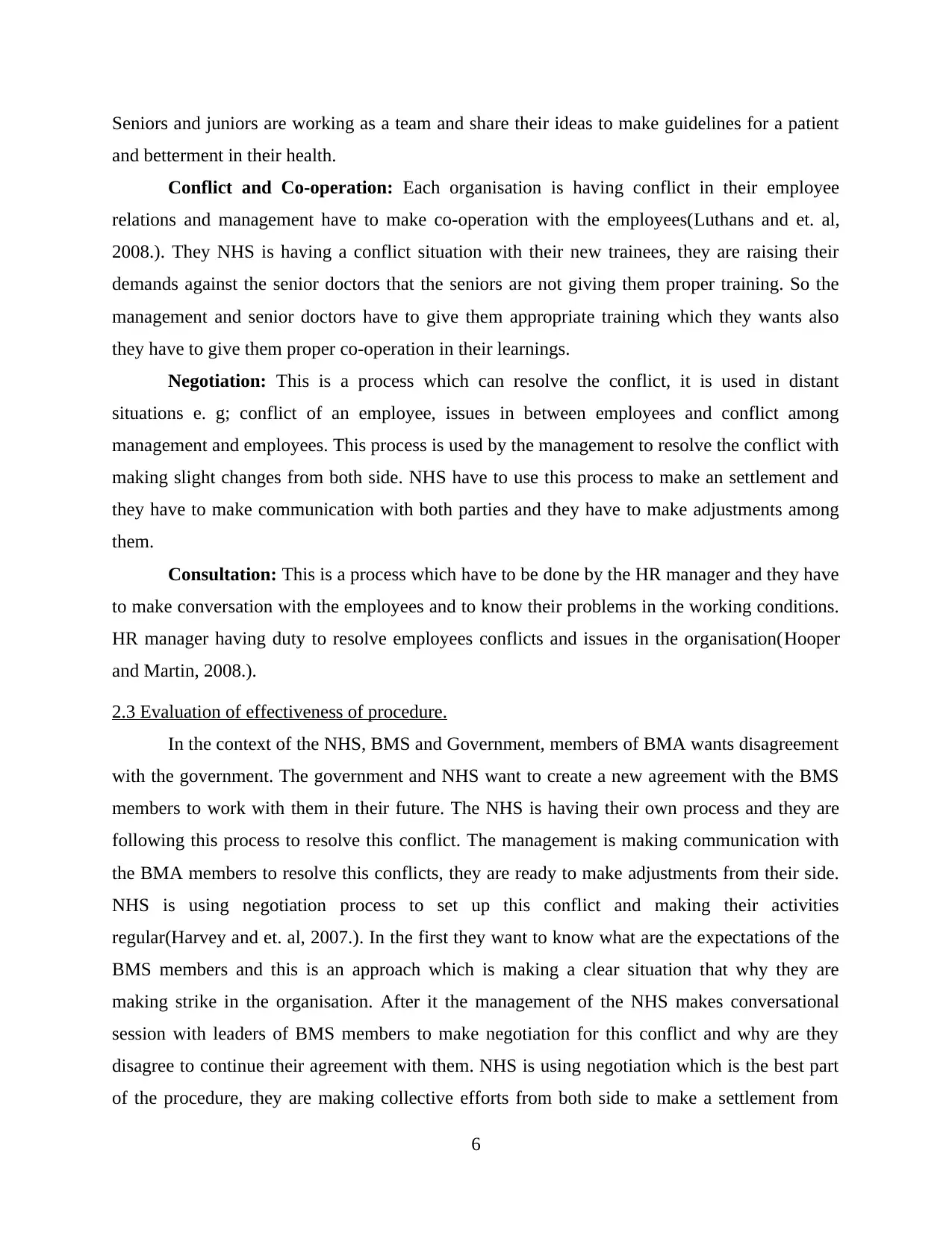
Seniors and juniors are working as a team and share their ideas to make guidelines for a patient
and betterment in their health.
Conflict and Co-operation: Each organisation is having conflict in their employee
relations and management have to make co-operation with the employees(Luthans and et. al,
2008.). They NHS is having a conflict situation with their new trainees, they are raising their
demands against the senior doctors that the seniors are not giving them proper training. So the
management and senior doctors have to give them appropriate training which they wants also
they have to give them proper co-operation in their learnings.
Negotiation: This is a process which can resolve the conflict, it is used in distant
situations e. g; conflict of an employee, issues in between employees and conflict among
management and employees. This process is used by the management to resolve the conflict with
making slight changes from both side. NHS have to use this process to make an settlement and
they have to make communication with both parties and they have to make adjustments among
them.
Consultation: This is a process which have to be done by the HR manager and they have
to make conversation with the employees and to know their problems in the working conditions.
HR manager having duty to resolve employees conflicts and issues in the organisation(Hooper
and Martin, 2008.).
2.3 Evaluation of effectiveness of procedure.
In the context of the NHS, BMS and Government, members of BMA wants disagreement
with the government. The government and NHS want to create a new agreement with the BMS
members to work with them in their future. The NHS is having their own process and they are
following this process to resolve this conflict. The management is making communication with
the BMA members to resolve this conflicts, they are ready to make adjustments from their side.
NHS is using negotiation process to set up this conflict and making their activities
regular(Harvey and et. al, 2007.). In the first they want to know what are the expectations of the
BMS members and this is an approach which is making a clear situation that why they are
making strike in the organisation. After it the management of the NHS makes conversational
session with leaders of BMS members to make negotiation for this conflict and why are they
disagree to continue their agreement with them. NHS is using negotiation which is the best part
of the procedure, they are making collective efforts from both side to make a settlement from
6
and betterment in their health.
Conflict and Co-operation: Each organisation is having conflict in their employee
relations and management have to make co-operation with the employees(Luthans and et. al,
2008.). They NHS is having a conflict situation with their new trainees, they are raising their
demands against the senior doctors that the seniors are not giving them proper training. So the
management and senior doctors have to give them appropriate training which they wants also
they have to give them proper co-operation in their learnings.
Negotiation: This is a process which can resolve the conflict, it is used in distant
situations e. g; conflict of an employee, issues in between employees and conflict among
management and employees. This process is used by the management to resolve the conflict with
making slight changes from both side. NHS have to use this process to make an settlement and
they have to make communication with both parties and they have to make adjustments among
them.
Consultation: This is a process which have to be done by the HR manager and they have
to make conversation with the employees and to know their problems in the working conditions.
HR manager having duty to resolve employees conflicts and issues in the organisation(Hooper
and Martin, 2008.).
2.3 Evaluation of effectiveness of procedure.
In the context of the NHS, BMS and Government, members of BMA wants disagreement
with the government. The government and NHS want to create a new agreement with the BMS
members to work with them in their future. The NHS is having their own process and they are
following this process to resolve this conflict. The management is making communication with
the BMA members to resolve this conflicts, they are ready to make adjustments from their side.
NHS is using negotiation process to set up this conflict and making their activities
regular(Harvey and et. al, 2007.). In the first they want to know what are the expectations of the
BMS members and this is an approach which is making a clear situation that why they are
making strike in the organisation. After it the management of the NHS makes conversational
session with leaders of BMS members to make negotiation for this conflict and why are they
disagree to continue their agreement with them. NHS is using negotiation which is the best part
of the procedure, they are making collective efforts from both side to make a settlement from
6
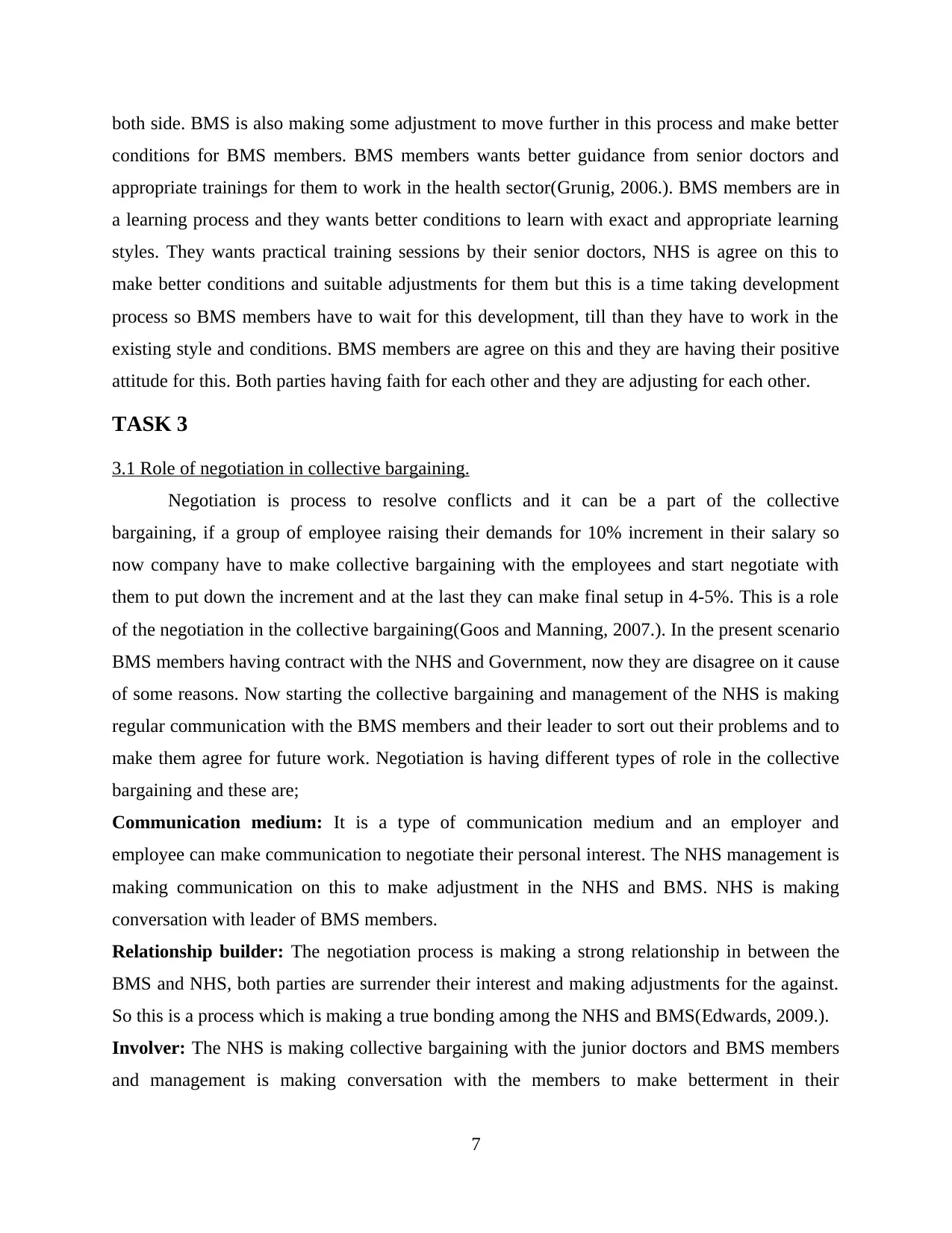
both side. BMS is also making some adjustment to move further in this process and make better
conditions for BMS members. BMS members wants better guidance from senior doctors and
appropriate trainings for them to work in the health sector(Grunig, 2006.). BMS members are in
a learning process and they wants better conditions to learn with exact and appropriate learning
styles. They wants practical training sessions by their senior doctors, NHS is agree on this to
make better conditions and suitable adjustments for them but this is a time taking development
process so BMS members have to wait for this development, till than they have to work in the
existing style and conditions. BMS members are agree on this and they are having their positive
attitude for this. Both parties having faith for each other and they are adjusting for each other.
TASK 3
3.1 Role of negotiation in collective bargaining.
Negotiation is process to resolve conflicts and it can be a part of the collective
bargaining, if a group of employee raising their demands for 10% increment in their salary so
now company have to make collective bargaining with the employees and start negotiate with
them to put down the increment and at the last they can make final setup in 4-5%. This is a role
of the negotiation in the collective bargaining(Goos and Manning, 2007.). In the present scenario
BMS members having contract with the NHS and Government, now they are disagree on it cause
of some reasons. Now starting the collective bargaining and management of the NHS is making
regular communication with the BMS members and their leader to sort out their problems and to
make them agree for future work. Negotiation is having different types of role in the collective
bargaining and these are;
Communication medium: It is a type of communication medium and an employer and
employee can make communication to negotiate their personal interest. The NHS management is
making communication on this to make adjustment in the NHS and BMS. NHS is making
conversation with leader of BMS members.
Relationship builder: The negotiation process is making a strong relationship in between the
BMS and NHS, both parties are surrender their interest and making adjustments for the against.
So this is a process which is making a true bonding among the NHS and BMS(Edwards, 2009.).
Involver: The NHS is making collective bargaining with the junior doctors and BMS members
and management is making conversation with the members to make betterment in their
7
conditions for BMS members. BMS members wants better guidance from senior doctors and
appropriate trainings for them to work in the health sector(Grunig, 2006.). BMS members are in
a learning process and they wants better conditions to learn with exact and appropriate learning
styles. They wants practical training sessions by their senior doctors, NHS is agree on this to
make better conditions and suitable adjustments for them but this is a time taking development
process so BMS members have to wait for this development, till than they have to work in the
existing style and conditions. BMS members are agree on this and they are having their positive
attitude for this. Both parties having faith for each other and they are adjusting for each other.
TASK 3
3.1 Role of negotiation in collective bargaining.
Negotiation is process to resolve conflicts and it can be a part of the collective
bargaining, if a group of employee raising their demands for 10% increment in their salary so
now company have to make collective bargaining with the employees and start negotiate with
them to put down the increment and at the last they can make final setup in 4-5%. This is a role
of the negotiation in the collective bargaining(Goos and Manning, 2007.). In the present scenario
BMS members having contract with the NHS and Government, now they are disagree on it cause
of some reasons. Now starting the collective bargaining and management of the NHS is making
regular communication with the BMS members and their leader to sort out their problems and to
make them agree for future work. Negotiation is having different types of role in the collective
bargaining and these are;
Communication medium: It is a type of communication medium and an employer and
employee can make communication to negotiate their personal interest. The NHS management is
making communication on this to make adjustment in the NHS and BMS. NHS is making
conversation with leader of BMS members.
Relationship builder: The negotiation process is making a strong relationship in between the
BMS and NHS, both parties are surrender their interest and making adjustments for the against.
So this is a process which is making a true bonding among the NHS and BMS(Edwards, 2009.).
Involver: The NHS is making collective bargaining with the junior doctors and BMS members
and management is making conversation with the members to make betterment in their
7
Secure Best Marks with AI Grader
Need help grading? Try our AI Grader for instant feedback on your assignments.
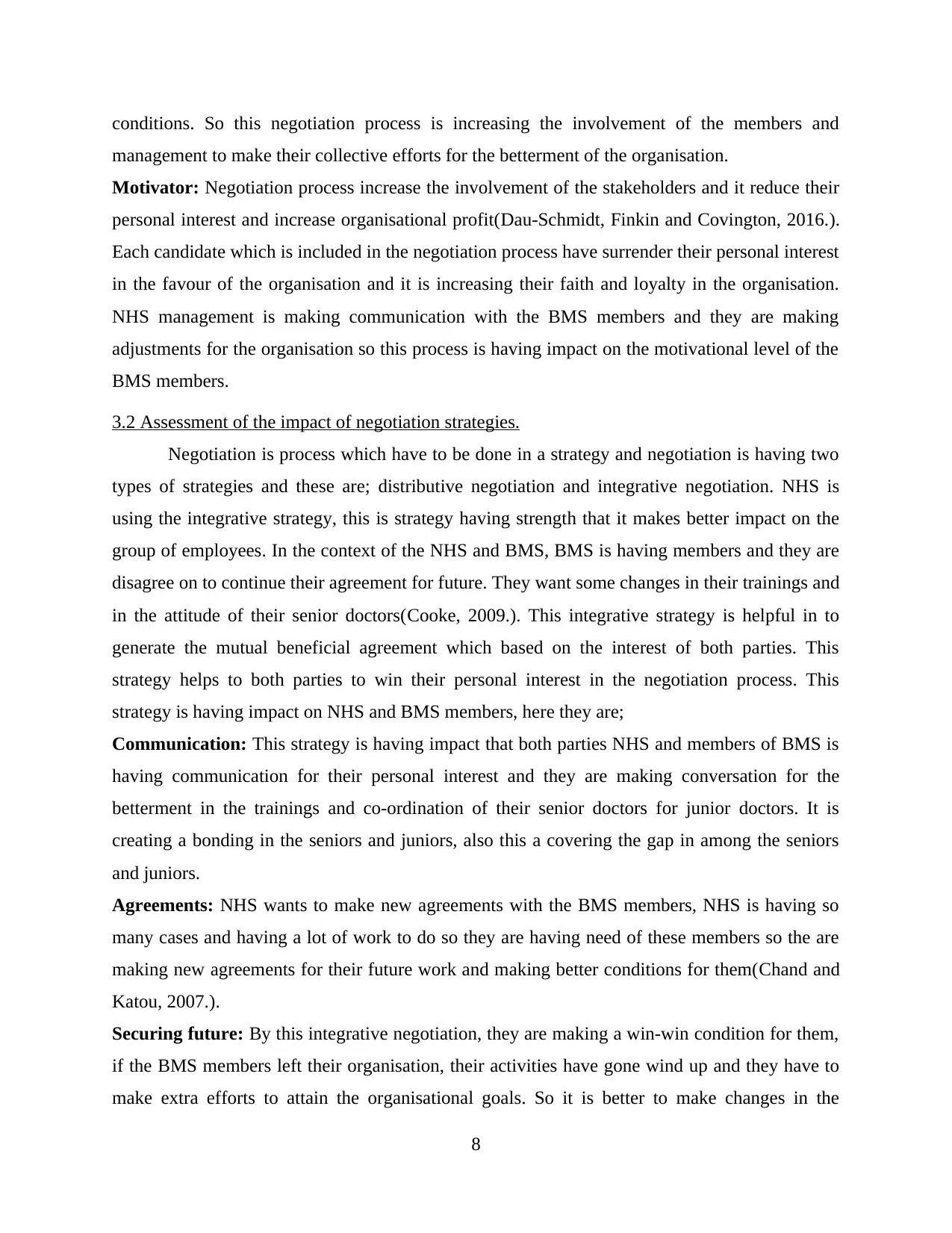
conditions. So this negotiation process is increasing the involvement of the members and
management to make their collective efforts for the betterment of the organisation.
Motivator: Negotiation process increase the involvement of the stakeholders and it reduce their
personal interest and increase organisational profit(Dau-Schmidt, Finkin and Covington, 2016.).
Each candidate which is included in the negotiation process have surrender their personal interest
in the favour of the organisation and it is increasing their faith and loyalty in the organisation.
NHS management is making communication with the BMS members and they are making
adjustments for the organisation so this process is having impact on the motivational level of the
BMS members.
3.2 Assessment of the impact of negotiation strategies.
Negotiation is process which have to be done in a strategy and negotiation is having two
types of strategies and these are; distributive negotiation and integrative negotiation. NHS is
using the integrative strategy, this is strategy having strength that it makes better impact on the
group of employees. In the context of the NHS and BMS, BMS is having members and they are
disagree on to continue their agreement for future. They want some changes in their trainings and
in the attitude of their senior doctors(Cooke, 2009.). This integrative strategy is helpful in to
generate the mutual beneficial agreement which based on the interest of both parties. This
strategy helps to both parties to win their personal interest in the negotiation process. This
strategy is having impact on NHS and BMS members, here they are;
Communication: This strategy is having impact that both parties NHS and members of BMS is
having communication for their personal interest and they are making conversation for the
betterment in the trainings and co-ordination of their senior doctors for junior doctors. It is
creating a bonding in the seniors and juniors, also this a covering the gap in among the seniors
and juniors.
Agreements: NHS wants to make new agreements with the BMS members, NHS is having so
many cases and having a lot of work to do so they are having need of these members so the are
making new agreements for their future work and making better conditions for them(Chand and
Katou, 2007.).
Securing future: By this integrative negotiation, they are making a win-win condition for them,
if the BMS members left their organisation, their activities have gone wind up and they have to
make extra efforts to attain the organisational goals. So it is better to make changes in the
8
management to make their collective efforts for the betterment of the organisation.
Motivator: Negotiation process increase the involvement of the stakeholders and it reduce their
personal interest and increase organisational profit(Dau-Schmidt, Finkin and Covington, 2016.).
Each candidate which is included in the negotiation process have surrender their personal interest
in the favour of the organisation and it is increasing their faith and loyalty in the organisation.
NHS management is making communication with the BMS members and they are making
adjustments for the organisation so this process is having impact on the motivational level of the
BMS members.
3.2 Assessment of the impact of negotiation strategies.
Negotiation is process which have to be done in a strategy and negotiation is having two
types of strategies and these are; distributive negotiation and integrative negotiation. NHS is
using the integrative strategy, this is strategy having strength that it makes better impact on the
group of employees. In the context of the NHS and BMS, BMS is having members and they are
disagree on to continue their agreement for future. They want some changes in their trainings and
in the attitude of their senior doctors(Cooke, 2009.). This integrative strategy is helpful in to
generate the mutual beneficial agreement which based on the interest of both parties. This
strategy helps to both parties to win their personal interest in the negotiation process. This
strategy is having impact on NHS and BMS members, here they are;
Communication: This strategy is having impact that both parties NHS and members of BMS is
having communication for their personal interest and they are making conversation for the
betterment in the trainings and co-ordination of their senior doctors for junior doctors. It is
creating a bonding in the seniors and juniors, also this a covering the gap in among the seniors
and juniors.
Agreements: NHS wants to make new agreements with the BMS members, NHS is having so
many cases and having a lot of work to do so they are having need of these members so the are
making new agreements for their future work and making better conditions for them(Chand and
Katou, 2007.).
Securing future: By this integrative negotiation, they are making a win-win condition for them,
if the BMS members left their organisation, their activities have gone wind up and they have to
make extra efforts to attain the organisational goals. So it is better to make changes in the
8
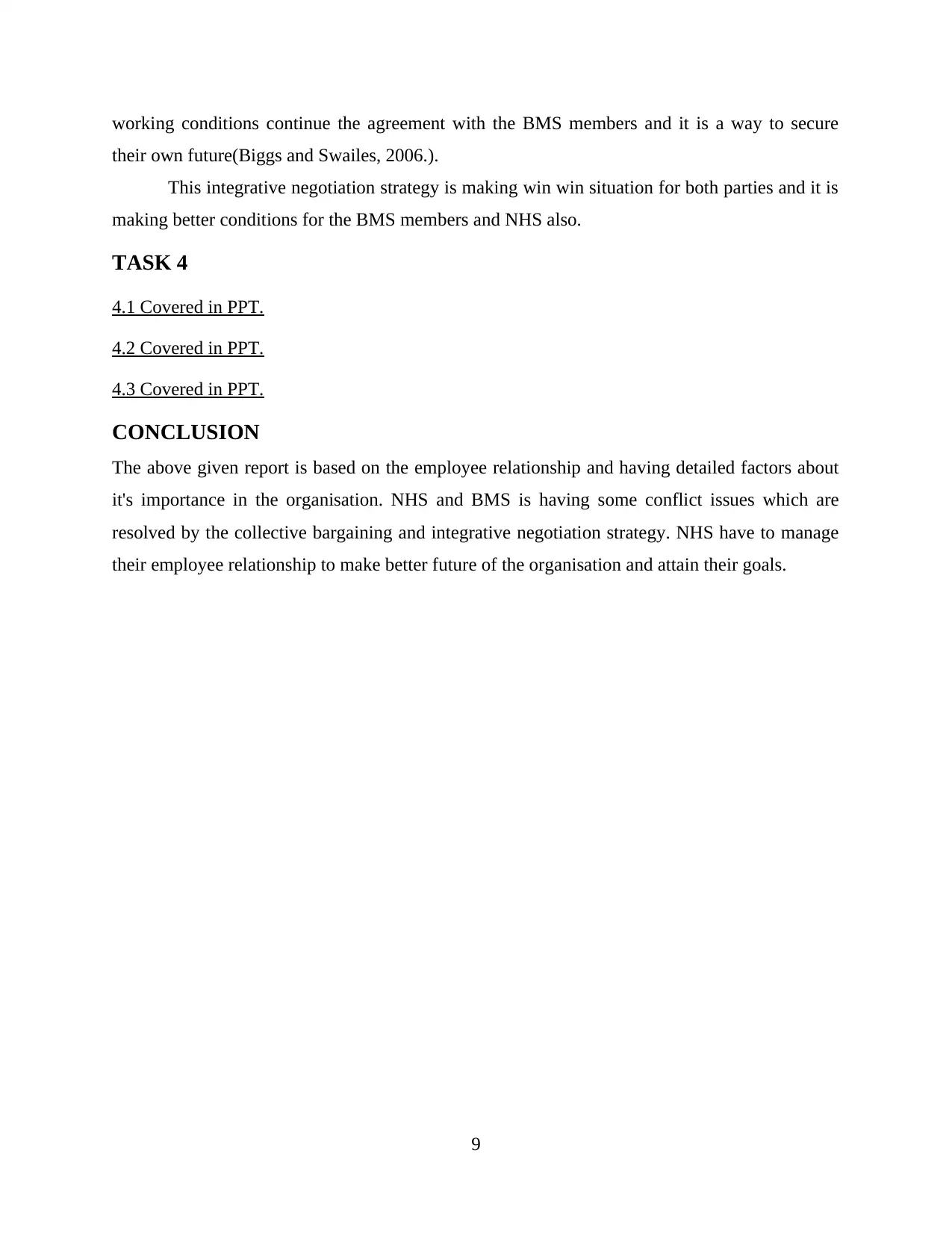
working conditions continue the agreement with the BMS members and it is a way to secure
their own future(Biggs and Swailes, 2006.).
This integrative negotiation strategy is making win win situation for both parties and it is
making better conditions for the BMS members and NHS also.
TASK 4
4.1 Covered in PPT.
4.2 Covered in PPT.
4.3 Covered in PPT.
CONCLUSION
The above given report is based on the employee relationship and having detailed factors about
it's importance in the organisation. NHS and BMS is having some conflict issues which are
resolved by the collective bargaining and integrative negotiation strategy. NHS have to manage
their employee relationship to make better future of the organisation and attain their goals.
9
their own future(Biggs and Swailes, 2006.).
This integrative negotiation strategy is making win win situation for both parties and it is
making better conditions for the BMS members and NHS also.
TASK 4
4.1 Covered in PPT.
4.2 Covered in PPT.
4.3 Covered in PPT.
CONCLUSION
The above given report is based on the employee relationship and having detailed factors about
it's importance in the organisation. NHS and BMS is having some conflict issues which are
resolved by the collective bargaining and integrative negotiation strategy. NHS have to manage
their employee relationship to make better future of the organisation and attain their goals.
9
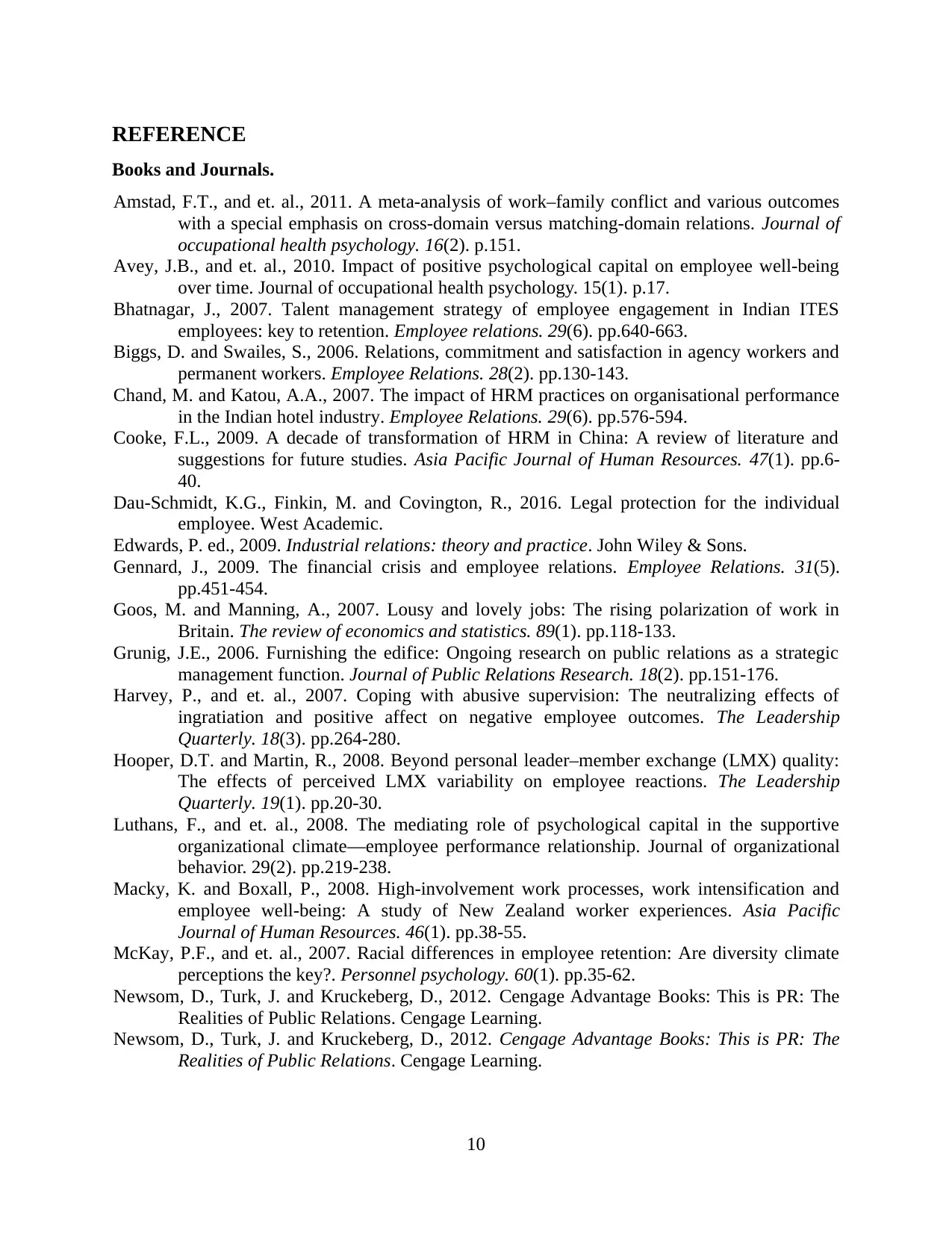
REFERENCE
Books and Journals.
Amstad, F.T., and et. al., 2011. A meta-analysis of work–family conflict and various outcomes
with a special emphasis on cross-domain versus matching-domain relations. Journal of
occupational health psychology. 16(2). p.151.
Avey, J.B., and et. al., 2010. Impact of positive psychological capital on employee well-being
over time. Journal of occupational health psychology. 15(1). p.17.
Bhatnagar, J., 2007. Talent management strategy of employee engagement in Indian ITES
employees: key to retention. Employee relations. 29(6). pp.640-663.
Biggs, D. and Swailes, S., 2006. Relations, commitment and satisfaction in agency workers and
permanent workers. Employee Relations. 28(2). pp.130-143.
Chand, M. and Katou, A.A., 2007. The impact of HRM practices on organisational performance
in the Indian hotel industry. Employee Relations. 29(6). pp.576-594.
Cooke, F.L., 2009. A decade of transformation of HRM in China: A review of literature and
suggestions for future studies. Asia Pacific Journal of Human Resources. 47(1). pp.6-
40.
Dau-Schmidt, K.G., Finkin, M. and Covington, R., 2016. Legal protection for the individual
employee. West Academic.
Edwards, P. ed., 2009. Industrial relations: theory and practice. John Wiley & Sons.
Gennard, J., 2009. The financial crisis and employee relations. Employee Relations. 31(5).
pp.451-454.
Goos, M. and Manning, A., 2007. Lousy and lovely jobs: The rising polarization of work in
Britain. The review of economics and statistics. 89(1). pp.118-133.
Grunig, J.E., 2006. Furnishing the edifice: Ongoing research on public relations as a strategic
management function. Journal of Public Relations Research. 18(2). pp.151-176.
Harvey, P., and et. al., 2007. Coping with abusive supervision: The neutralizing effects of
ingratiation and positive affect on negative employee outcomes. The Leadership
Quarterly. 18(3). pp.264-280.
Hooper, D.T. and Martin, R., 2008. Beyond personal leader–member exchange (LMX) quality:
The effects of perceived LMX variability on employee reactions. The Leadership
Quarterly. 19(1). pp.20-30.
Luthans, F., and et. al., 2008. The mediating role of psychological capital in the supportive
organizational climate—employee performance relationship. Journal of organizational
behavior. 29(2). pp.219-238.
Macky, K. and Boxall, P., 2008. High-involvement work processes, work intensification and
employee well-being: A study of New Zealand worker experiences. Asia Pacific
Journal of Human Resources. 46(1). pp.38-55.
McKay, P.F., and et. al., 2007. Racial differences in employee retention: Are diversity climate
perceptions the key?. Personnel psychology. 60(1). pp.35-62.
Newsom, D., Turk, J. and Kruckeberg, D., 2012. Cengage Advantage Books: This is PR: The
Realities of Public Relations. Cengage Learning.
Newsom, D., Turk, J. and Kruckeberg, D., 2012. Cengage Advantage Books: This is PR: The
Realities of Public Relations. Cengage Learning.
10
Books and Journals.
Amstad, F.T., and et. al., 2011. A meta-analysis of work–family conflict and various outcomes
with a special emphasis on cross-domain versus matching-domain relations. Journal of
occupational health psychology. 16(2). p.151.
Avey, J.B., and et. al., 2010. Impact of positive psychological capital on employee well-being
over time. Journal of occupational health psychology. 15(1). p.17.
Bhatnagar, J., 2007. Talent management strategy of employee engagement in Indian ITES
employees: key to retention. Employee relations. 29(6). pp.640-663.
Biggs, D. and Swailes, S., 2006. Relations, commitment and satisfaction in agency workers and
permanent workers. Employee Relations. 28(2). pp.130-143.
Chand, M. and Katou, A.A., 2007. The impact of HRM practices on organisational performance
in the Indian hotel industry. Employee Relations. 29(6). pp.576-594.
Cooke, F.L., 2009. A decade of transformation of HRM in China: A review of literature and
suggestions for future studies. Asia Pacific Journal of Human Resources. 47(1). pp.6-
40.
Dau-Schmidt, K.G., Finkin, M. and Covington, R., 2016. Legal protection for the individual
employee. West Academic.
Edwards, P. ed., 2009. Industrial relations: theory and practice. John Wiley & Sons.
Gennard, J., 2009. The financial crisis and employee relations. Employee Relations. 31(5).
pp.451-454.
Goos, M. and Manning, A., 2007. Lousy and lovely jobs: The rising polarization of work in
Britain. The review of economics and statistics. 89(1). pp.118-133.
Grunig, J.E., 2006. Furnishing the edifice: Ongoing research on public relations as a strategic
management function. Journal of Public Relations Research. 18(2). pp.151-176.
Harvey, P., and et. al., 2007. Coping with abusive supervision: The neutralizing effects of
ingratiation and positive affect on negative employee outcomes. The Leadership
Quarterly. 18(3). pp.264-280.
Hooper, D.T. and Martin, R., 2008. Beyond personal leader–member exchange (LMX) quality:
The effects of perceived LMX variability on employee reactions. The Leadership
Quarterly. 19(1). pp.20-30.
Luthans, F., and et. al., 2008. The mediating role of psychological capital in the supportive
organizational climate—employee performance relationship. Journal of organizational
behavior. 29(2). pp.219-238.
Macky, K. and Boxall, P., 2008. High-involvement work processes, work intensification and
employee well-being: A study of New Zealand worker experiences. Asia Pacific
Journal of Human Resources. 46(1). pp.38-55.
McKay, P.F., and et. al., 2007. Racial differences in employee retention: Are diversity climate
perceptions the key?. Personnel psychology. 60(1). pp.35-62.
Newsom, D., Turk, J. and Kruckeberg, D., 2012. Cengage Advantage Books: This is PR: The
Realities of Public Relations. Cengage Learning.
Newsom, D., Turk, J. and Kruckeberg, D., 2012. Cengage Advantage Books: This is PR: The
Realities of Public Relations. Cengage Learning.
10
Paraphrase This Document
Need a fresh take? Get an instant paraphrase of this document with our AI Paraphraser
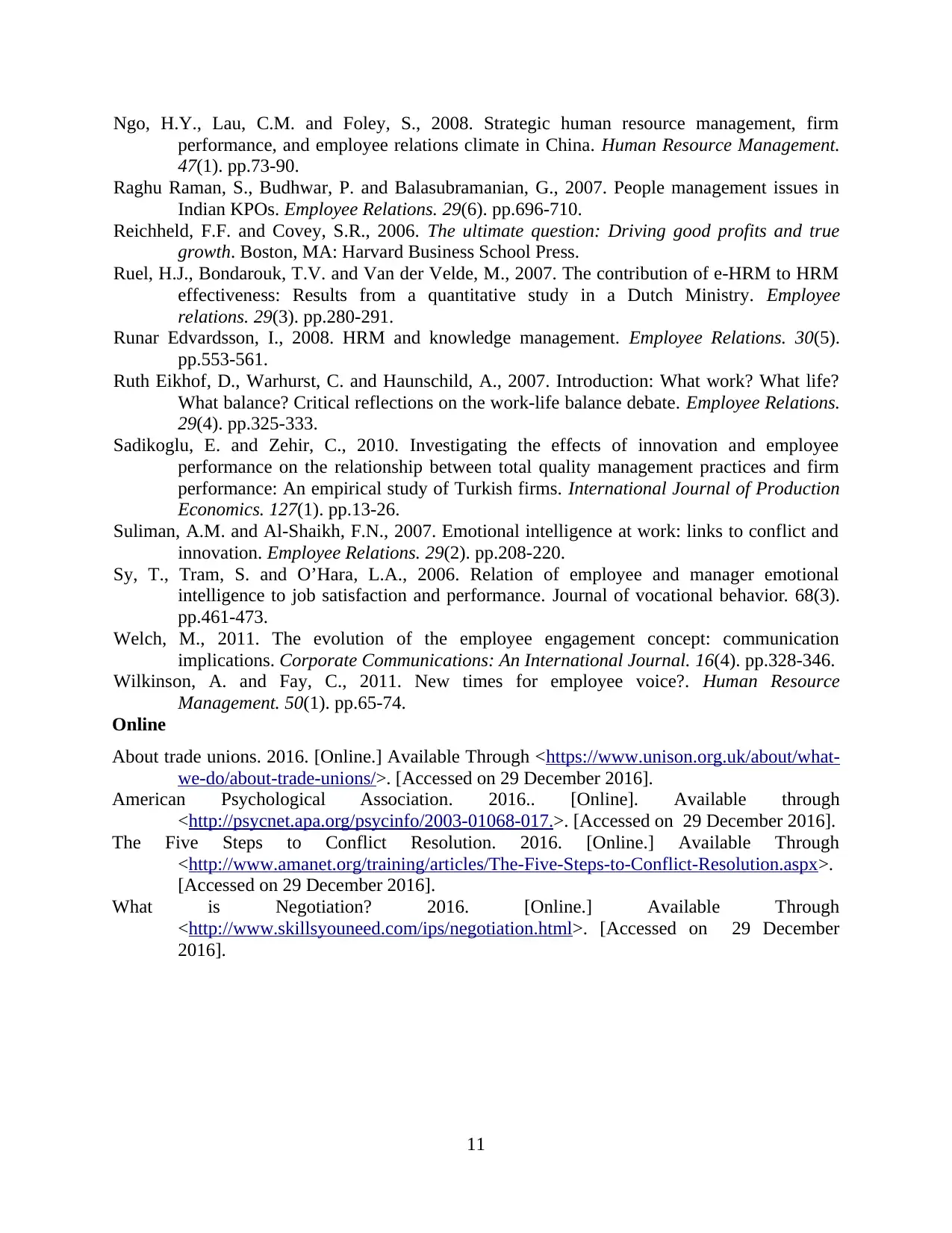
Ngo, H.Y., Lau, C.M. and Foley, S., 2008. Strategic human resource management, firm
performance, and employee relations climate in China. Human Resource Management.
47(1). pp.73-90.
Raghu Raman, S., Budhwar, P. and Balasubramanian, G., 2007. People management issues in
Indian KPOs. Employee Relations. 29(6). pp.696-710.
Reichheld, F.F. and Covey, S.R., 2006. The ultimate question: Driving good profits and true
growth. Boston, MA: Harvard Business School Press.
Ruel, H.J., Bondarouk, T.V. and Van der Velde, M., 2007. The contribution of e-HRM to HRM
effectiveness: Results from a quantitative study in a Dutch Ministry. Employee
relations. 29(3). pp.280-291.
Runar Edvardsson, I., 2008. HRM and knowledge management. Employee Relations. 30(5).
pp.553-561.
Ruth Eikhof, D., Warhurst, C. and Haunschild, A., 2007. Introduction: What work? What life?
What balance? Critical reflections on the work-life balance debate. Employee Relations.
29(4). pp.325-333.
Sadikoglu, E. and Zehir, C., 2010. Investigating the effects of innovation and employee
performance on the relationship between total quality management practices and firm
performance: An empirical study of Turkish firms. International Journal of Production
Economics. 127(1). pp.13-26.
Suliman, A.M. and Al-Shaikh, F.N., 2007. Emotional intelligence at work: links to conflict and
innovation. Employee Relations. 29(2). pp.208-220.
Sy, T., Tram, S. and O’Hara, L.A., 2006. Relation of employee and manager emotional
intelligence to job satisfaction and performance. Journal of vocational behavior. 68(3).
pp.461-473.
Welch, M., 2011. The evolution of the employee engagement concept: communication
implications. Corporate Communications: An International Journal. 16(4). pp.328-346.
Wilkinson, A. and Fay, C., 2011. New times for employee voice?. Human Resource
Management. 50(1). pp.65-74.
Online
About trade unions. 2016. [Online.] Available Through <https://www.unison.org.uk/about/what-
we-do/about-trade-unions/>. [Accessed on 29 December 2016].
American Psychological Association. 2016.. [Online]. Available through
<http://psycnet.apa.org/psycinfo/2003-01068-017.>. [Accessed on 29 December 2016].
The Five Steps to Conflict Resolution. 2016. [Online.] Available Through
<http://www.amanet.org/training/articles/The-Five-Steps-to-Conflict-Resolution.aspx>.
[Accessed on 29 December 2016].
What is Negotiation? 2016. [Online.] Available Through
<http://www.skillsyouneed.com/ips/negotiation.html>. [Accessed on 29 December
2016].
11
performance, and employee relations climate in China. Human Resource Management.
47(1). pp.73-90.
Raghu Raman, S., Budhwar, P. and Balasubramanian, G., 2007. People management issues in
Indian KPOs. Employee Relations. 29(6). pp.696-710.
Reichheld, F.F. and Covey, S.R., 2006. The ultimate question: Driving good profits and true
growth. Boston, MA: Harvard Business School Press.
Ruel, H.J., Bondarouk, T.V. and Van der Velde, M., 2007. The contribution of e-HRM to HRM
effectiveness: Results from a quantitative study in a Dutch Ministry. Employee
relations. 29(3). pp.280-291.
Runar Edvardsson, I., 2008. HRM and knowledge management. Employee Relations. 30(5).
pp.553-561.
Ruth Eikhof, D., Warhurst, C. and Haunschild, A., 2007. Introduction: What work? What life?
What balance? Critical reflections on the work-life balance debate. Employee Relations.
29(4). pp.325-333.
Sadikoglu, E. and Zehir, C., 2010. Investigating the effects of innovation and employee
performance on the relationship between total quality management practices and firm
performance: An empirical study of Turkish firms. International Journal of Production
Economics. 127(1). pp.13-26.
Suliman, A.M. and Al-Shaikh, F.N., 2007. Emotional intelligence at work: links to conflict and
innovation. Employee Relations. 29(2). pp.208-220.
Sy, T., Tram, S. and O’Hara, L.A., 2006. Relation of employee and manager emotional
intelligence to job satisfaction and performance. Journal of vocational behavior. 68(3).
pp.461-473.
Welch, M., 2011. The evolution of the employee engagement concept: communication
implications. Corporate Communications: An International Journal. 16(4). pp.328-346.
Wilkinson, A. and Fay, C., 2011. New times for employee voice?. Human Resource
Management. 50(1). pp.65-74.
Online
About trade unions. 2016. [Online.] Available Through <https://www.unison.org.uk/about/what-
we-do/about-trade-unions/>. [Accessed on 29 December 2016].
American Psychological Association. 2016.. [Online]. Available through
<http://psycnet.apa.org/psycinfo/2003-01068-017.>. [Accessed on 29 December 2016].
The Five Steps to Conflict Resolution. 2016. [Online.] Available Through
<http://www.amanet.org/training/articles/The-Five-Steps-to-Conflict-Resolution.aspx>.
[Accessed on 29 December 2016].
What is Negotiation? 2016. [Online.] Available Through
<http://www.skillsyouneed.com/ips/negotiation.html>. [Accessed on 29 December
2016].
11
1 out of 14
Related Documents
Your All-in-One AI-Powered Toolkit for Academic Success.
+13062052269
info@desklib.com
Available 24*7 on WhatsApp / Email
![[object Object]](/_next/static/media/star-bottom.7253800d.svg)
Unlock your academic potential
© 2024 | Zucol Services PVT LTD | All rights reserved.





